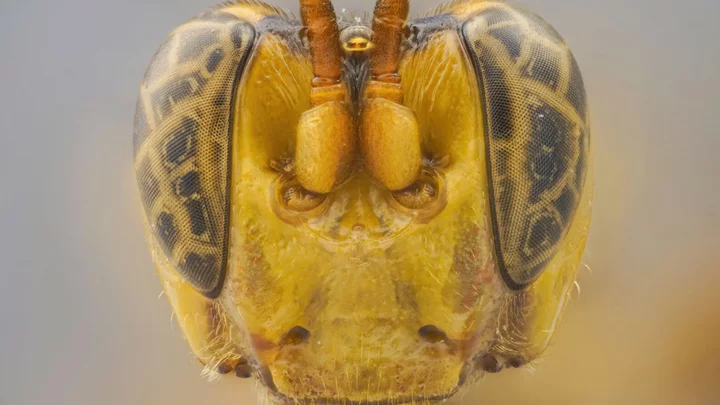
Netflix Games wants to bring Grand Theft Auto to subscribers
It's been claimed that the subscription service is looking to add "higher-end games", such as 'GTA'.
2023-10-17 20:18

Shell’s CEO Reassures Staff That He Believes in Climate Action
Shell Plc Chief Executive Officer Wael Sawan told the company’s staff that he “believes in urgent climate action,”
2023-10-17 19:54

Vodafone, Three execs tell lawmakers their UK merger will benefit 5G, jobs
LONDON Executives from Vodafone and CK Hutchison's Three UK unit said their 15 billion pound ($18 billion) merger
2023-10-17 19:22

Scientists unveil 'missing' law of nature in landmark discovery
A group of scientists and philosophers claim to have identified a “missing law of nature”, in a discovery which has huge implications for our understanding of how, basically, everything works. Most of us are familiar with the names – if not the intricacies – of many of the physical laws which govern the world and beyond, such as gravity and thermodynamics. And yet, no established physical law has been able to describe the behaviours of countless complex systems that exist across the universe – until now. In a paper published in the PNAS journal on 16 October, a multidisciplinary team from some of the US’s top institutes and universities, unveiled a new law claiming to do just that. In a nutshell, their law states that evolution is not limited to life on Earth, it also occurs in other massively complex systems – from planets to atoms. This means that these systems naturally “evolve” to states of greater diversity, and complexity. In other words, the researchers found evolution to be a common feature of the natural world's complex systems which, according to the Carnegie Institution for Science, comprise the following characteristics: “They are formed from many different components, such as atoms, molecules, or cells, that can be arranged and rearranged repeatedly “Are subject to natural processes that cause countless different configurations to be formed.” Only a small fraction of these configurations survive via a process of natural selection called “selection for function”. According to the researchers, regardless of whether the system is living or nonliving, when a new configuration works and function improves, evolution occurs. The authors' new law – which they have christened "the Law of Increasing Functional Information" – states that the system will evolve "if many different configurations of the system undergo selection for one or more functions." "An important component of this proposed natural law is the idea of 'selection for function,'" the study’s lead author, astrobiologist Dr Michael L. Wong, explained. The team’s research builds on Charles Darwin’s theory of natural selection, which suggests the function exists to ensure the “survival of the fittest”. For their work, Dr Wong and his team expanded on this perspective, pointing to the existence of three types of this selection for function in nature. The first, most basic type, they claim, is stability – the stable arrangements of atoms or molecules which are selected to continue. Second, are dynamic systems which are selected for their ongoing supplies of energy. And the third, and most intriguing, function is "novelty" – the tendency of evolving systems to explore new configurations which can lead to surprising new behaviours or characteristics. Novelties are, ironically, nothing new. Indeed, life’s evolutionary history is rich with examples: photosynthesis evolved when single cells learned to harness light energy; multicellular life evolved when cells learned to cooperate; and species evolved thanks to advantageous new behaviours such as walking and thinking. The same type of evolution happens in the mineral kingdom, as the Carnegie Institution for Science notes in a release published by Phys.org. Indeed, Earth's minerals, which began with about 20 at the dawn of our solar system, now number almost 6,000 known today. This is thanks to the ever more complex physical, chemical, and biological processes which have occurred over the past 4.5 billion years. The paper also notes that just two major elements – hydrogen and helium – formed the first stars shortly after the big bang. Those earliest stars then used this hydrogen and helium to create around 20 heavier chemical elements, which was built upon by the next generation of stars. "Charles Darwin eloquently articulated the way plants and animals evolve by natural selection, with many variations and traits of individuals and many different configurations," co-author and research lead Robert M. Hazen explained. "We contend that Darwinian theory is just a very special, very important case within a far larger natural phenomenon. “The notion that selection for function drives evolution applies equally to stars, atoms, minerals, and many other conceptually equivalent situations where many configurations are subjected to selective pressure." The new law has a number of exciting implications, including a deeper understanding of how the Universe itself came to exist. It could also help explain how life differs from other complex evolving systems, and could help aid the search for life elsewhere. Furthermore, at a time when increasingly autonomous AI systems are of increasing concern, it’s very handy to have a law that characterises how both natural and symbolic systems evolve. It also offers insights into how we could artificially influence the rate of evolution of some systems which, again, could prove invaluable. The key point to remember, as Dr Wong put it, is that whilst life is the “most striking example of evolution”, it’s not the only one. Evolution, it transpires, is everywhere. Sign up for our free Indy100 weekly newsletter Have your say in our news democracy. Click the upvote icon at the top of the page to help raise this article through the indy100 rankings.
2023-10-17 19:20

Climate Protesters Block Oil Executives From London Event
Hundreds of protesters are causing havoc outside a London hotel, blocking several top oil executives from entering to
2023-10-17 19:15

The Earth is being polluted by space junk, scientists discover
Minuscule traces of metal from space junk that's designed to be disposable are invisibly polluting the Earth's atmosphere, a new study has found. In recent times, spacecrafts launched into space have been designed so that they fall out of orbit and fall back down to Earth after their intended use. So instead of the materials crashing on land, they can burn up in the upper atmosphere. Although the debris of rockets and satellites burn up when re-entering the planet's atmosphere, the consequences of metal vapour being left behind currently remain unknown. But given the amount of space exploration taking place, the amount of metal vapour is expected to rise in the years to come. Physicist Daniel Murphy of the National Oceanic and Atmospheric Administration (NOAA) has led a team of researchers to investigate what effects this metal vapour could have as well as its impact over time and this study was published in Proceedings of the National Academy of Sciences, as per Science Alert. He listed "iron, silicon, and magnesium from the natural meteoric source" as the current refractory material in stratospheric particular. Murphy has warned how this composition could be affected by the metal vapour from space junk. "However, the amount of material from the reentry of upper-stage rockets and satellites is projected to increase dramatically in the next 10 to 30 years," he wrote. "As a result, the amount of aluminum in stratospheric sulfuric acid particles is expected to become comparable to or even exceed the amount of meteoric iron, with unknown consequences for inclusions and ice nucleation." To find out if metal vapour remained, Murphy and his team took and analyzed 500,000 stratospheric aerosol droplet samples to see if they had traces of spacecraft metals. Aerosols contain sulfuric acid droplets made from the oxidation of the carbonyl sulfide gas and in the atmosphere, this can appear naturally or as a pollutant. Metal and silicon traces can be found in these droplets too, acquired from meteors which vaporize upon atmospheric entry. Around 20 metals were discovered from this research, and while some metals had similar ratios to the vaporizing meteors, other metals such as lithium, aluminium, copper, and lead exceeded the anticipated amounts. Particles from vaporized spacecraft were found in 10 per cent of stratospheric aerosols over a certain size while other common spacecraft metals such as niobium and hafnium were also present. Consequently, these traces of spacecraft particles could affect how water freezes into ice in the stratosphere, and stratospheric aerosol particles could change in size. Due to more space exploration planned in an "era of rapid growth" for the industry, the researchers predict "the percentage of stratospheric sulfuric acid particles that contain aluminum and other metals from satellite reentry will be comparable to the roughly 50 per cent that now contain meteoric metals." Sign up to our free Indy100 weekly newsletter Have your say in our news democracy. Click the upvote icon at the top of the page to help raise this article through the indy100 rankings.
2023-10-17 18:50

Russia fines Zoom $1.18 million for operating without local office -RIA
MOSCOW A Russian court on Tuesday fined Zoom Video Communications 115 million roubles ($1.18 million) for operating without
2023-10-17 18:46

Nukefluencers Are On a Quest to Push Clean Power From Reactors
Let’s meet the newest generation of nuclear activists. There’s a Brazilian model. Miss America. A nonprofit founder who
2023-10-17 18:45

A parasitic wasp with a giant head has been discovered and it's the stuff of nightmares
Scientists have unearthed a new species of wasp in the Amazon – and it's rather terrifying. The alien-looking parasitic creature came to light when a team at Utah State University were researching Allpahuayo-Mishana National Reserve in Peru. The wasp, known as Capitojoppa amazonica, has a giant almond-shaped head and is known to latch on to prey before sucking its blood and then eating it from the inside. It does so by laying eggs in its victims including caterpillars, beetles and spiders. The study’s lead author, biologist Brandon Claridge called the practice a "solitary endoparasitoid". "Once the host is located and mounted, the female will frantically stroke it with her antennae," Claridge told Live Science in an email. "If acceptable, the female will deposit a single egg inside the host by piercing it with her ovipositor (a tube-like, egg-laying organ)." He went on to explain that in some instances, "females will even stab the host with the ovipositor and feed without laying an egg as it helps with gaining nutrients for egg maturation." This isn't the first horrifying discovery, with researchers recently finding a new species of tarantula in Thailand that is characterised with illuminous blue legs. The spider is one of the rarest in the world, with Dr Narin Chomphuphuang explaining how it lurks in hollow trees. "The difficulty of catching an electric-blue tarantula lies in the need to climb a tree and lure it out of a complex of hollows," he explained. "During our expedition, we walked in the evening and at night during low tide, managing to collect only two of them." Sign up for our free Indy100 weekly newsletter Have your say in our news democracy. Click the upvote icon at the top of the page to help raise this article through the indy100 rankings.
2023-10-17 18:23

South Africa Says It Can Raise $60 Billion for Its Transition to Green Energy
South Africa may be able to raise as much as 1.13 trillion rand ($60 billion) over the next
2023-10-17 17:55

Adobe unveils futuristic ‘digital dress’ that changes patterns on the go
Software company Adobe unveiled a new futuristic “digital dress” that lets wearers change patterns on its surface on the fly with the click of a button. The dress, created under Adobe’s “Project Primrose”, is made of sequins which are “reflective light-diffuser modules” built using liquid crystals such as those in smart lighting. Researchers say the sequins are basically tiny screens built using smart materials. The dress was unveiled for the first time for the audience at Adobe’s MAX conference last week with the software company describing it as bringing “fabric to life”. Video from the conference showed Adobe researcher Christine Dierk wearing the strapless outfit, which appeared like an average cocktail dress on first impression, but the patterns on it begin to shift immediately with the touch of a remote button. “Unlike traditional clothing, which is static, Primrose allows me to refresh my look in a moment,” the Adobe scientist said while demonstrating that its colors can go from light to dark in a moment. The researcher-turned-model also showed that the dress not only had static changes, but also animated designs with patterns fading in and out. Ms Dierk, who not only designed the dress but also stitched it herself, demonstrated that the outfit will even respond to movement. Researchers say the dress is built using “reflective-backed polymer-dispersed liquid crystal (PDLC)” a material commonly used in smart windows. “This low-power non-emissive material can be cut to any shape, and dynamically diffuses light,” scientists wrote in a study presented at a tech conference last year, but it remains unclear how heavy the dress can actually get. “Designers can layer this technology into clothing, furniture, and other surfaces to unlock infinite style possibilities – such as the ability to download and wear the latest design from a favorite designer,” Adobe noted. They said the high-tech sequins are also used for smaller products part of Project Primrose including a handbag and a canvas. “We hope this work inspires future designers of flexible displays,” scientists said. Read More Photo giant Getty took a leading AI image-maker to court. Now it's also embracing the technology John Warnock, who helped invent the PDF and co-founded Adobe Systems, dies at age 82 In closed forum, tech titans to give senators advice on artificial intelligence Tell us if you think price is the biggest problem with electric cars Sadiq Khan, Met Commissioner to ask phone companies to ‘design out’ theft TikTok details plans for Israel-Hamas war posts
2023-10-17 17:51

Amazon to launch online shopping service in South Africa in 2024
JOHANNESBURG (Reuters) -U.S. ecommerce firm Amazon said on Tuesday it would launch its online shopping service in South Africa in
2023-10-17 16:59
